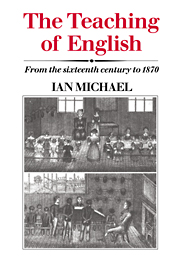Book contents
- Frontmatter
- Contents
- List of tables
- Preface
- 1 The enquiry: scope, method, texts
- 2 Reading, spelling, pronunciation: the elements
- 3 Reading, spelling, pronunciation: the skills
- 4 Interpretation: literature presented
- 5 Interpretation: literature taught
- 6 Expression and performance
- 7 Linguistic control
- 8 English: the development of a subject
- Abbreviations
- Bibliography 1
- Bibliography 2
- Bibliography 3
- Bibliography 4
- Index
1 - The enquiry: scope, method, texts
Published online by Cambridge University Press: 05 June 2012
- Frontmatter
- Contents
- List of tables
- Preface
- 1 The enquiry: scope, method, texts
- 2 Reading, spelling, pronunciation: the elements
- 3 Reading, spelling, pronunciation: the skills
- 4 Interpretation: literature presented
- 5 Interpretation: literature taught
- 6 Expression and performance
- 7 Linguistic control
- 8 English: the development of a subject
- Abbreviations
- Bibliography 1
- Bibliography 2
- Bibliography 3
- Bibliography 4
- Index
Summary
The enquiry
The intentions and limitations of this enquiry are an essential part of it: they do not belong to a preface, even though they are expressed in personal terms. The enquiry has two sources. I have always been puzzled by statements that English is a relatively recent addition to the curriculum:
1983 ‘[It is surprising] how recently English has entered the curriculum … Our very notion of literacy – of a functional command of reading and writing – is a development of the nineteenth century.’
1978 ‘English is a comparatively new subject.’
1974 ‘A young subject, less than one hundred years old … It is not till the end of the nineteenth century that there was anything even approximating what we now roughly subsume under the heading “the study of English”.’
1919 ‘Of conscious and direct teaching of English the past affords little sign.’
The second line of thought was also interrogative. I was surprised that historians of education, whose work on the institutional, social and legislative aspects of their subject was sometimes detailed and vivid, said so little about what happened in the classroom itself. It seemed unlikely that there was no evidence, and even more unlikely that such evidence could be dull. These two lines of thought coalesced into an intention to see what early evidence there was for the teaching of English in school.
- Type
- Chapter
- Information
- The Teaching of EnglishFrom the Sixteenth Century to 1870, pp. 1 - 13Publisher: Cambridge University PressPrint publication year: 1987

